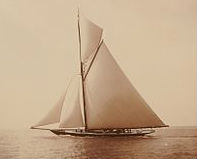 HMY Britannia was the personal sailing yacht of two British kings. Built in 1893 for Albert Edward, Prince of Wales, who later became King Edward VII, the Britannia would also be sailed by his son, King George V. Designed by the Scottish designer, George Lennox Watson, the yacht won 231 races and took another 129 flags over her long racing career. The Britannia followed King George V to his grave. In accordance with his dying wish, on 10 July 1936, the yacht was stripped of her spars and fittings and her hull towed out to St Catherines Deep near the Isle of Wight where she was scuttled. Britannia‘s burgee and racing flag were presented to the Royal Dorset Yacht Club, where they are still on display.
HMY Britannia was the personal sailing yacht of two British kings. Built in 1893 for Albert Edward, Prince of Wales, who later became King Edward VII, the Britannia would also be sailed by his son, King George V. Designed by the Scottish designer, George Lennox Watson, the yacht won 231 races and took another 129 flags over her long racing career. The Britannia followed King George V to his grave. In accordance with his dying wish, on 10 July 1936, the yacht was stripped of her spars and fittings and her hull towed out to St Catherines Deep near the Isle of Wight where she was scuttled. Britannia‘s burgee and racing flag were presented to the Royal Dorset Yacht Club, where they are still on display.
Old Salt Blog
a virtual port of call for all those who love the sea , hosted by nautical novelist Rick Spilman

Video by K1 Britannia, the structures which will leverage the Britannia replica for charity around the world:
https://www.youtube.com/watch?v=OtQRGBWaqy4&feature=youtu.be&nohtml5=False#t=20.334535
If you wish to see her original gaff spar it is hanging, impressively, from the ceiling in the Duke of York pub in West Cowes. It was made by Fifes of Fairlie who made most of the large UK spars for these leviathans. It is, I guess, forty feet long and two feet in diameter. The spar was made from first turning a log into a constant diameter and then halving it along its length. The two halves were then hollowed out until the wall thickness was about two and a half inches. One half was turned end for end and the two halves were then glued together to make a stable, strong and light spar.
This would have been used with rings to support the vertical weight of the sail but as strikes began to appear, wire mousings would have been added with wooden spacers and battens to allow the rings to negotiate them. These are fitted to the Duke of York’s spar but the original wire mousings have been replaced by rope.
The spar was discovered hanging in a warehouse when a ceiling was removed and the now owner bought it for £2000 but if he sells it any profit will be split with the original owner 50/50.
The spar was to be put in place by Claire Lallow Boatbuilders and their gang appeared one evening as dinner was being served. They passed it through an opening from a removed window and as it entered the building, it was realised that a hole would need to be punched through an existing wall and this was quickly achieved. Nobody’s dinner was interrupted, it was just another night out in Cowes.